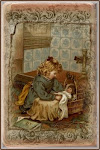
PENNANT BANNER:
 Here's how to make them
Here's how to make themTo make two 3 yard long banners, you need to have 1/2 yard of 4-5 different fabrics and two packs of double fold bias tape (3 yrds long).

Create a plastic triangle template with a 6 inch base and 10 inch height.
Fold a piece of fabric in half, right sides together, matching the selvedges. If you place the base on the triangle along the bottom edge of the fabric and cut, then turn the template upside down so the point is at the bottom edge and cut, you should be able to cut 10 triangle pairs from a 1/2 yard of fabric. You're cutting through 2 layers of fabric, so you should have two identical triangles. Keep the pair together! 5 different fabrics will leave you with enough extra triangles to start on a third banner.
With right sides together, sew along the long sides of the triangles with a 1/2" seam allowance. Leave the base open. Trim the seams to 1/4" inch. Turn triangle right side out and press. Use a scissor point to get a nice point on the triangle. Repeat for all triangles. (It really doesn't take as long as you might think.)


 Super, super easy! And kind of fun!
Super, super easy! And kind of fun!Instead of pennant banners why not make an Easter Egg one...

CARAMELIZING ONIONS
 caramelizing onions, just for the record this is the first step in about half the things I make, so I thought I'd go over it once. I know people who've thought 'caramelizing onions' meant adding sugar, but that's not the case. it just means heating the onions over low heat till translucent. the process brings out the sugar within the onion, taking away the bitterness (and resultant onion breath). if you take the onions all the way to browned--keep stirring!--you'll be surprised how sweet an onion can be. smells great, too.
caramelizing onions, just for the record this is the first step in about half the things I make, so I thought I'd go over it once. I know people who've thought 'caramelizing onions' meant adding sugar, but that's not the case. it just means heating the onions over low heat till translucent. the process brings out the sugar within the onion, taking away the bitterness (and resultant onion breath). if you take the onions all the way to browned--keep stirring!--you'll be surprised how sweet an onion can be. smells great, too.More tidbits for you!
FREEZING BACON:
 When you buy bacon..roll each slice into a pin curl and freeze individually.
When you buy bacon..roll each slice into a pin curl and freeze individually.Then when you need just a few slices for a recipe you will be able to use what you need and chop it fine very easily for what you need it for.I have been doing this for years...

OMG! These look so good, and so easy to make. Basically, you buy a tube of pre-made cinnamon rolls, unroll each one, place a strip of bacon inside and roll it back up. Cook according to the instructions on the tube and you’re done!
FREEZING CHICKEN STOCK/BROTH:

Pour into an ice cube tray, freeze, then pop them out and put into a plastic freezer bag...One tray full of cubes is 2 cups of chicken stock/broth..
You can also use the regular muffin tins....Each tin is 1/2 cup of broth/stock..

FOOD STORAGE SAFETY TIPS:
 Storing foods can present its own set of problems. And different types of foods have different storage requirements to prevent bacteria from setting in. Here's some tips to protect your family and yourself.
Storing foods can present its own set of problems. And different types of foods have different storage requirements to prevent bacteria from setting in. Here's some tips to protect your family and yourself.Storing Vegetables
1. Vegetables should be stored in the vegetable crisper in the refrigerator. However, keep potatoes, sweet potatoes, onions, and garlic in a cool, dark, well ventilated place, but not in the refrigerator. Tomatoes have better flavor if they are not refrigerated. Once cut, tomatoes should be refrigerated like any vegetable.
2. Store vegetables in the refrigerator crisper in plastic bags to prevent loss of moisture and nutritional values. However, eggplant and capsicums should be stored open in the crisper as they sweat if stored in plastic bags. Put mushrooms in a paper bag (not in a plastic bag) before placing them in the crisper.
Storing Fruits
3. Apples and berries should always be kept in the refrigerator for maximum crispness. Summer stone fruits and melons should sit at room temperature until they are ripe, then go into the refrigerator. Grapes & fruits that are not yet fully ripe can be left in a fruit bowl in the kitchen.
4. Citrus fruits are fine at room temperature unless it is very hot, in which case, put them in the refrigerator. Bananas should be kept at cool room temperature. Their skins become black if they are refrigerated, although the flesh is still fine to eat.
Storing Dairy Products
5. Always check the expiry date on dairy products, especially milk. Don't buy milk if it will expire in 2-3 days. Milk generally starts giving smell before its expire date even if you store it in the refrigerator! Generally, milk bottles at the front of the shelf in the supermarket have an expiry date of only a few days. Look for bottles at the back of the shelf.
Storing Frozen Foods
6. Pack all your frozen foods together in an insulated container to keep them frozen until you get home. If foods defrost on the way home and you re-freeze them in a domestic freezer, large ice crystals will form and can rupture cell membranes in the food allowing nutrients to escape. Keep frozen foods frozen to maintain quality, as bacteria will begin to multiply when the food is thawed.
Storing Meat Products
7. Fresh meat, chicken, and fish always carry some bacteria so these foods must always be kept cold. Bacterial growth slows down in the refrigerator; at room temperature, they grow rapidly. Cooking kills these bacteria. Store meat, seafood and chicken in the coldest part of the refrigerator. See that any uncooked products do not come into contact with other foods in the refrigerator. They should be stored at the bottom part of the refrigerator so that any juices that drip out won't contaminate other foods on lower shelves.
8. Make sure that fish or other seafood are wrapped and use as soon as possible. Throw them out if not used within two days.
9. If you are going to freeze meat, seafood or poultry, enclose it in freezer wrap and freeze as soon as possible after bringing it home. Store eggs in the refrigerator, preferably in their cartons, as it provides protection and prevents moisture loss through the shell.
Storing Other Products
10. Do not allow pet foods to come into contact with human foods. Pantry items (canned foods, cereals, etc.) should be stored in a dark place like in a cupboard or pantry. Keep oils out of direct








.JPG)



.jpg)






































































.jpg)


























.JPG)















No comments:
Post a Comment